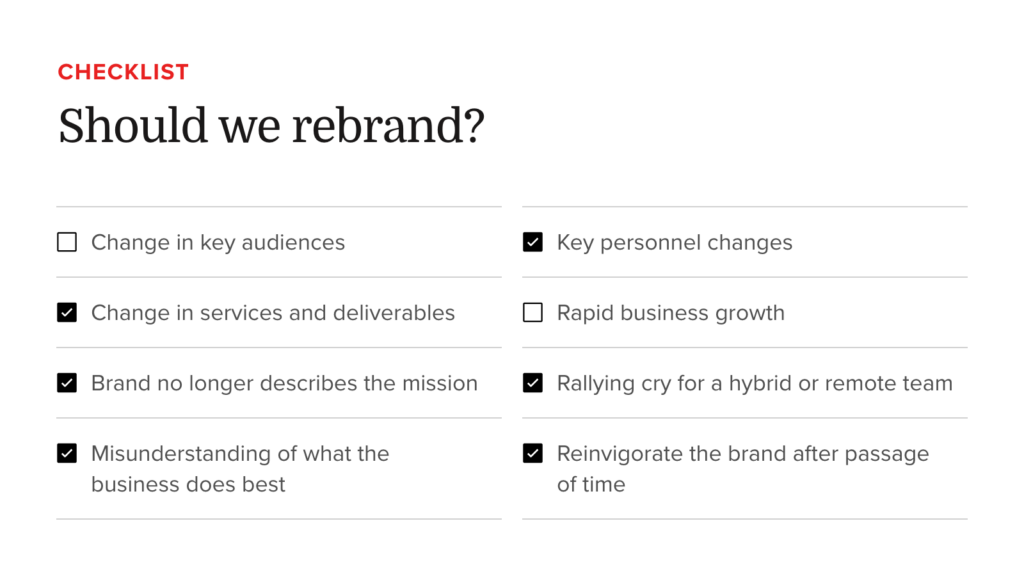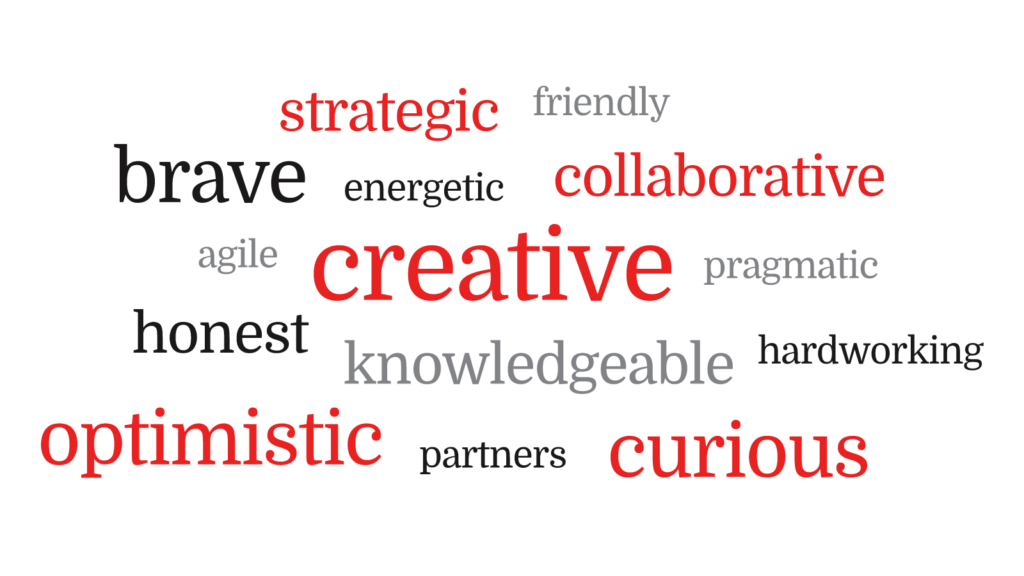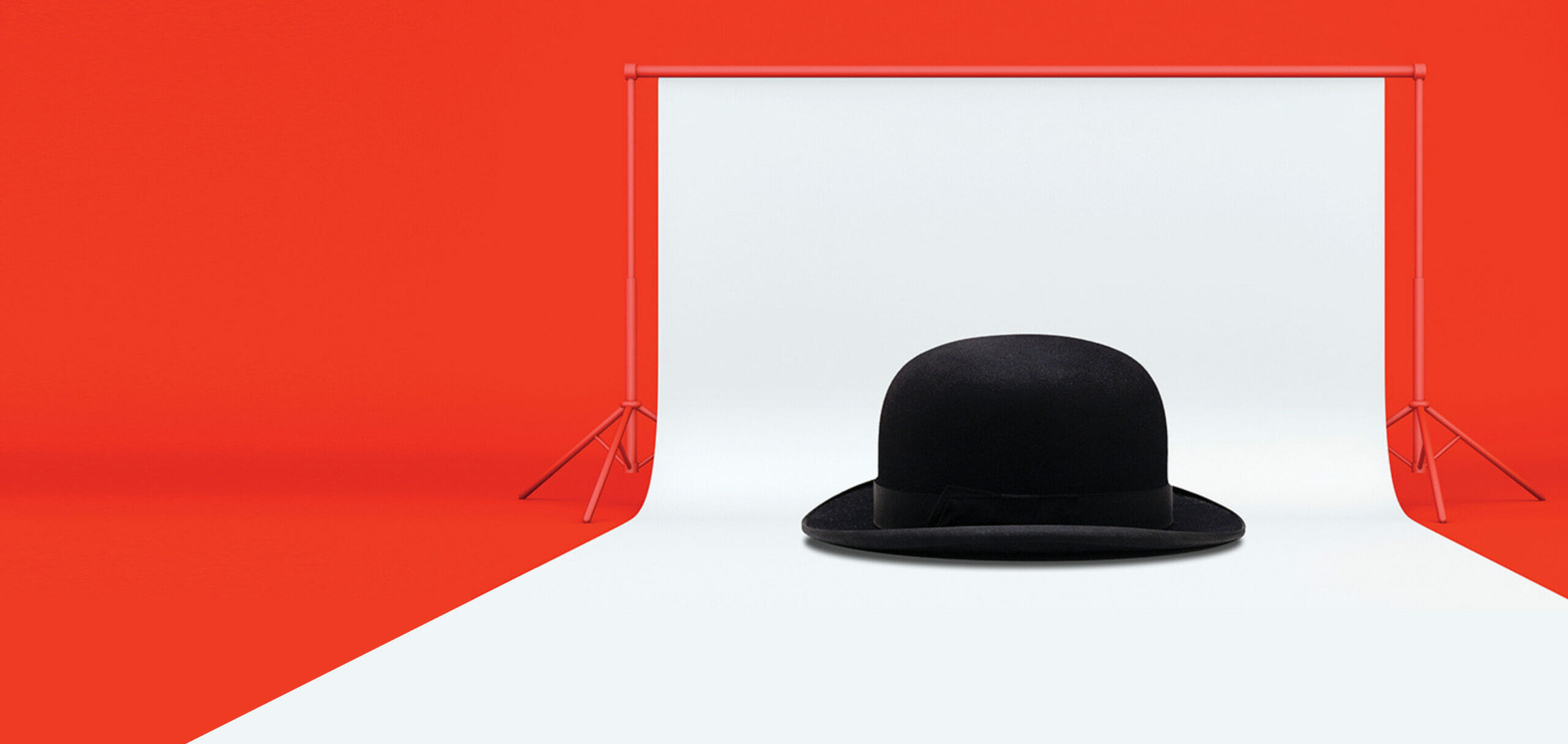What happens when the brand experts decide to rebrand themselves?
Recently, the brand experts at Right Hat took on our toughest challenge — rebranding our own firm. While we’ve led dozens of rebrands for clients, putting ourselves under the microscope deepened our understanding of what it’s like to be at the center of the process. So, we’re sharing our experience — and the most important lessons we learned — with you.
“I Thought You Guys Only Did Big Branding Projects”
That comment, from a client, was the catalyst that launched a thousand meetings. After 17 years in business, Right Hat had a well-earned reputation for branding work, with more than 80 rebrands to our credit. Our own brand, “Bringing clarity to the complex,” spoke to our unique understanding of professional services and our ability to translate technical jargon and intangible offerings into high-impact communications.
But, like every other industry, professional services marketing had changed, and so had our work.
We had expanded our digital horizons (hello, interactive brochures and online ad campaigns!). We were producing storyboards for audiences used to consuming information on video. We took on one-off campaigns for special initiatives like Diversity, Equity & Inclusion (DEI), recruiting and geographic expansion. Content-only projects like thought-leadership pieces and professional biographies became part of our offering. Following Covid layoffs and the Great Resignation, we developed retainer arrangements to work with short-staffed clients as an extension of their in-house teams.
At the same time, we underwent a partial change in leadership, with new people and fresh ideas joining the company. With so much change happening and many team members now working remotely, we wanted to make sure we stayed on mission, delivering creative solutions that delight our clients.
Is Now the Right Time?
Rebranding is part of the life cycle of every business. At the same time, it’s a time-consuming process that demands commitment and resources. To begin, we went through a discovery process to see if we met our own criteria for a rebrand.
We interviewed current clients, former clients and even people who’d never hired us. It turned out that no one knew the full scope of what we do. Some thought we only did full brand projects, some thought our focus was on corporate identity, and some thought we only did websites.
We talked about their thought process in choosing a design firm — their logical hiring criteria. We heard that our experience in the business and legal fields was important in saving ramp-up time and avoiding dead-end ideas, and that our research provided confidence and ammunition to sell designs upstream. And we heard that our ability to work with their preferred web development partner was distinctly helpful.
Flexibility was also important — clients and prospects wanted to be able to plug us in for projects other than full rebrands, — like brand extensions, naming and audits. They wanted to be able to start with a small project and expand as needs (and budgets) dictate. They wanted, quite simply, MORE.
Because hiring decisions — and effective brands — are emotional as well as logical, we asked how clients and prospects wanted to feel about their creative team. What we heard was that they wanted to feel inspired. Bingo! We wanted that, too! And we knew we could deliver.
Here’s what our final “should we rebrand?” checklist looked like:

The Brand Summit
The brand summit meeting is critical to our brand discovery process. This is where we gather client stakeholders to identify their organization’s key strengths and value to buyers. We followed the same process for our own rebrand. Using well-established brainstorming and consensus-building techniques, we collected everyone’s favorite descriptors of our firm, discussed them, and held ranked-choice voting to see what would rise to the top. Some of the biggest vote-getters were Creative, Curious, Optimistic and Brave.

Diving deeper, we saw that courage, curiosity and optimism are the three core traits that drive our creative output. Curiosity is what pushes us to learn all we can about individual clients, to engage in industry-wide research and to look outside professional services for the latest marketing tools and trends. Bravery is the boldness to push the creative envelope and to be candid with our clients about what works and what doesn’t. As for optimism, we bring it to every assignment, knowing we can work within a client’s budget, timeline and other limitations to create something they’ll be proud of today and into the future. Together, these traits feed our imagination and inspire creativity.
We challenged our team to take this input and create a defining brand statement for Right Hat. One broad enough to encompass all the aspects of our creative products and client services. And one that would speak to what clients want to experience, not just what we wanted to say.
Putting on the Hats
To come up with our brand statement, we used the Six Thinking Hats technique pioneered by Dr. Edward de Bono. We put on our (figurative) Green Hat to generate ideas without judgment, our Yellow Hat to find the positives of each, our White Hat to incorporate facts and research in our decision-making, our Red Hat to surface instincts and emotional responses, and our Black Hat to evaluate risk. Wearing these different hats creates a safe space to ideate as well as a framework for discussion, different viewpoints and (when needed) constructive nonpersonal criticism. Sometimes we found ourselves wearing more than one hat at a time, and that is when we pulled out our Blue Hat to keep ourselves on task and to make sure we followed the process.
The Stumbling Blocks
It would be nice to say that the team came back in a week with one perfect brand statement, everyone jumped on board, and that was that. But of course, branding rarely works that way. In fact, we experienced many of the same problems that our clients do.
Meetings were postponed or missed due to client deadlines and emergencies (sound familiar?). People disagreed about their preferred options. An idea we fell in love with turned out to be too close to a competitive brand.
But finally, we had it. A brand statement that gave us goosebumps and made us excited about the future. That made us a little nervous because it is a big bold promise. (Which is, of course, exactly what you want when creating a memorable brand.) Our new brand would be (drumroll, please): Imagine More.
Imagine More is a promise to our clients, and a challenge to ourselves, to embrace new ideas, defy limits, and bring curiosity, courage and optimism to all we do.
To keep learning — about your business, your needs and your audiences.
To combine our industry knowledge with a determination to push past the ordinary — and help you stand out.
To focus on what can be done, not what can’t.
And to keep evolving so we can bring you the very best in design, strategy and content.
Lessons From Our Self-Brand
As we officially launch our Imagine More brand, we’re also looking back on what we’ve learned along the way. It’s been an exciting process, and the twists and turns have given us a new understanding of the challenges our clients face. Here are our top tips for rebrand success:
- Get the right people in the room. A good working group includes people with institutional knowledge, new ideas and outside perspective. They should be positive, collaborative and committed to sticking with the process even if times get tough.
- Know what a brand can do. It can’t make you into something that you’re not, but it can showcase the best of what you are. It can’t reflect everything you do, but it can help the market remember an important reason to choose you.
- Understand your why.Many brand projects stall because the stakeholders don’t agree about what they are trying to achieve. Make sure you are in sync on your key message.
- Get out of your heads. Brand headlines aren’t literal. They are there to make a fast, strong, emotional connection. Start by getting someone to feel good about hiring you, then give them evidence to back up the decision they want to make.
- Be nimble. If something happens and you have to change course, do it fast. For example, if you’ve found a brand statement that describes you perfectly, but a competitor has already claimed the territory, you may need to pivot (even if your claim is stronger). Rip off the Band-Aid and move on. There are more good ideas out there.
- Have a decision-making process. Don’t assume that smart, well-meaning people will easily reach consensus in the absence of guardrails. Provide a process where the loudest voice in the room doesn’t necessarily win. There are time-tested approaches that give everyone an equal chance to be heard. Decide in advance how you’ll decide, and then abide by it.
- Conquer social (media) anxiety. Nowadays, every strong brand provokes a response on social media, and they won’t all be positive. People may take shots to get attention for themselves, or because they wish they’d thought of your idea first, or for any number of reasons. Don’t let the fear of a few negative comments scare you away from a bold idea. A brand that gets noticed and spurs a reaction is a good thing.
Our clients and partners will be instrumental in helping us bring our new brand to life by imagining more right along with us. We’re excited to keep imagining!
